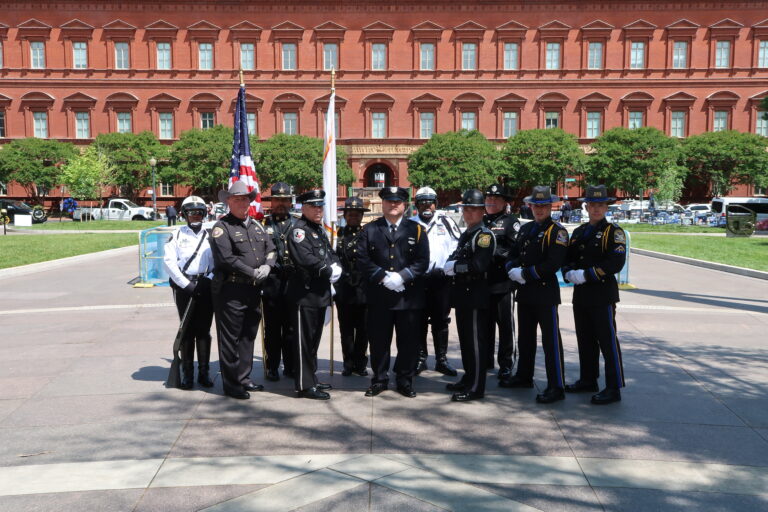
The “Stand Watch for the Fallen” ceremony that takes place at the National Law Enforcement Officers Memorial during National Police Week in Washington, DC, is a solemn and poignant tradition for law enforcement officers from across the United States to gather to honor their fallen comrades. During the ceremony, Honor Guards stand in silent vigil, paying tribute to their fallen colleagues by standing guard at the Memorial. This symbolic act serves as a reminder of the sacrifices made by law enforcement officers and their dedication to protecting their communities. It is a powerful demonstration of solidarity and remembrance within the law enforcement community. In 2023, the NLEOMF Ambassador program had the privilege of opening Stand Watch for the Fallen. This is the story of all those who contributed to making that inaugural ceremony a reality.
In the months preceding National Police Week 2023, during the online monthly Ambassador team meetings and subsequent emails, Ambassador Ryan Grelle (TX) suggested our Ambassador team take the first rotation of the Stand Watch for the Fallen detail. Knowing that several Ambassadors had considerable ceremonial experience, it seemed appropriate for Ambassadors to take the first watch.
As discussions on this possibility developed, the conversation quickly shifted to the realization that while officers were “standing watch” at the memorial, nothing would be present to represent it. Something was missing—something that not only represented the Memorial but also the reason it stands: the fallen heroes that quietly rest in valor on the walls of Judiciary Square. The vision of developing a wreath that would represent the Memorial and all those who have given that “last full measure of devotion” began to take shape very quickly.
After numerous calls to many area florists and fabricators experienced in constructing something like this, Silk Thumb Florists of Wyandotte, MI, whose owner, Deb Paducha, was a good friend of Ambassador Dan Foley (MI), agreed to the task. Silk Thumb, specialized in high-end custom silk floral arrangements, had handled several specialized requests in the past, including wreaths for formal ceremonies at the Tomb of the Unknown Soldier in Arlington National Cemetery.
At first, concerns were expressed over the size, weight, construction, and custom floral content required to complete it within such a short period. Several designs were brainstormed, and the final design was approved by Bill Alexander, then Executive Officer for the National Law Enforcement Officers Memorial. The wreath would be 48” in diameter, matching that of the main center plate at the memorial, and would be two-dimensional to give depth of appearance and texture. The entire wreath would be assembled using the finest handmade silk floral, with the base and shield engineered out of Maple plywood and painted/sealed for weather resistance.
The final design and authorization of the wreath took approximately two weeks to complete, causing considerable concern that the supplies needed may not be available in time. Subsequently, the focus shifted to the formal dedication ceremony. A wreath-laying ceremony based on the outline followed at the Tomb of the Unknown Soldier in Arlington National Cemetery was developed by Foley with adjustments made to accommodate the varied skill sets and experience of the Ambassador team.
Additionally, a Color Guard and TAPS were added to the ceremony. Detroit PD agreed to handle TAPS, and both Detroit PD and Wayne County Sheriff’s Office (MI) agreed to provide a joint Color Guard team. With the ceremonial order of service finalized, attention returned to completing the wreath, as time was running short.
West Bloomfield PD (MI) offered to transport the 4’ wreath to Washington, DC, using a van driven by two Honor Guard members. After meticulous planning and coordination, the wreath arrived at the NLEOMF administrative offices on May 12th, in time for the formal inaugural ceremony.
On May 15th, with the team assembled, members of the Ambassador Program, joined by fellow officers, officially commenced the Stand Watch for the Fallen ceremony. Remaining true to their mission, the event unfolded with reverence and homage to those who made the ultimate sacrifice in upholding the laws of our nation. As Ambassador Tom Ross articulated in his opening remarks, “Whether it’s your first visit or you walk these grounds every day, the peace and serenity of this hallowed place should overwhelm you. I’ve often felt that the ghosts of our fallen walk amongst these Walls. They guide us to go home and continue our duty to remember.”
The success of this project was made possible by the collaboration of numerous agencies, individuals, officers, and businesses, each embodying the memorial’s motto: Respect, Honor, Remember. A special thanks to those who made this possible:
Transport Team West Bloomfield Police (MI) Honor Guard: Ofc. Joe Miller (Team Leader), Ofc. Chad Kerr, and Ofc. James Parrott. Color Guard Wayne County Sheriff’s Office (MI) Honor Guard: Captain Reid Chakrabarty, Cpl. Carlos Banks, Cpl. April Love. Color Guard / TAPS Detroit Police (MI) Honor Guard: Cpl. Jeremy Rozycki, Cpl. Chontel Jones, Det. Lewis Jackson. Order of Ceremony NLEOMF Ambassador Daniel R. Foley Wyandotte (MI) Police Dept. (Ret) MI Sheriff’s & Municipal Memorial Assistance Response Team (SMMART). Connecticut State Police Honor Guard Team Ambassador Mark Roberts and Connor Hourigan. And the Numerous NLEOMF Ambassadors that came from around the country to take part in the first Annual Ambassador Wreath Laying: Ryan Grelle and Perry Moose (TX), Ezekiel Zimmerman (MD), Tom Ross (OH), Joe Flannagan (CA).

